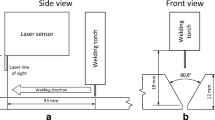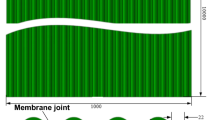Abstract
This paper has proposed a new method for welding procession monitoring and controlling. A Cartesian welding experimental platform is firstly setup. Then welding experiments can be performed and several groups of welding images can be captured by the vision sensor. A composite filtering system is set up and used to filter the weld arc disturbance. Then median filter and grey level transformation operations are performed to enhance the contrast of processing district on the image. On this basis,the grey centroid of weld pool C, the width of outer weld pool W, the width of inner weld pool N and welding current I are seem to be the heat distribution condition parameters. The weld seam error e and the welding penetertion condition p are used to be the welding conditon detection parameters. A BP neural network is used to set up the relationship between the heat distribution condition parameters and the welding condition detection parameters. In the end, several testing experiments are performed. The resluts show that the pediction value of the tracking error are fit to the measuring value, and the average tracking error is 0.011 mm. The accuracy rate of the model for welding penetration prediction is up to 95%.











Similar content being viewed by others
References
Kang, Z., Lilong, C.: Online nugget diameter control system for resistance spot welding. Int. J. Adv. Manuf. Technol. 68(9–12), 2571–2588 (2013)
Ping, Y., JiaXiang, X., Kang, Z., XiaoJun, W., Qiang, Z.: Symmetrical transition waveform control on double-wire MIG welding. J. Mater. Process. Technol. 229, 111–120 (2016)
Ranjan, R., Talati, A., Ho, M., Bharmal, H., Bavdekar, V.A.: Multivariate data analysis of gas-metal arc welding process. IFAC Papersonline 48(8), 463–468 (2015)
Mohamed, M.A., Manurung, Y.H.P., Berhan, M.N.: Model development for mechanical properties and weld quality class of friction stir welding using multi-objective Taguchi method and response surface methodology. J. Mech. Sci. Technol. 29(6), 2323–2331 (2015)
Jiuchun, Y.A.N., Chunli, Y.A.N.G., Huijie, L.I.U., et al.: Overview on ultrasonic-assisted welding and its scientific issues. J. Mech. Eng. 51(24), 41–49 (2015)
Patham, B., Foss, P.H.: Thermoplastic vibration welding: review of process phenomenology and processing-structure-property interrelationships. Polym. Eng. Sci. 51(1), 1–22 (2015)
Kaplan, A.: Modelling of the absorptivity increase in conduction laser spot welding. Biol. Neonate 75(5), 279–284 (2015)
Huang, Y., Wang, Y., Wan, L., Liu, H., Shen, J., Santos, J.F., Zhou, L., Feng, J.: Material-flow behavior during friction-stir welding of 6082–T6 aluminum alloy. Int. J. Adv. Manuf. Technol. 87(1–4), 1115–1123 (2016)
Li, J., Li, H., Wei, H., Gao, Y.: Effect of torch position and angle on welding quality and welding process stability in pulse on pulse MIG welding-brazing of aluminum alloy to stainless steel. Int. J. Adv. Manuf. Technol. 84(1), 705–716 (2016)
Paoletti, A., Lambiase, F., Ilio, A.D.: Analysis of forces and temperatures in friction spot stir welding of thermoplastic polymers. Int. J. Adv. Manuf. Technol. 83(5), 1395–1407 (2016)
Ren W.: Vision-based sensing of the weld pool penetration in PAW. Thesis for Master Degree of Shandong University, pp. 1–39 (2014)
Xu Y.: research on real-time tracking and control technology of three-dimension welding seam during welding robot GTAW process based on vision sensor and arc sensor. Ph.D Degree Dissertation of Shanghai Jiao Tong University, pp. 1–87 (2013)
Jianbin, J., Hasegawa, H., Suga, Y.: Oscillation of molten poolby pulsed assist gas oscillating method and penetration control using peculiar frequency. J. High Temp. Soc. 30(5), 263–269 (2015)
Xiangdong, G., Yonghua, L.: Detection formation of micro-gap seam offset based on wavelet trans-formation during high-power fiber laser welding. Trans. China Weld. Inst. 36(3), 1–4 (2015)
Ping, Y., Kang, Z., Qiang, Z.: Quantitative evaluation method of arc sound spectrum based on sample entropy. Mech. Syst. Signal Process. 92, 379–390 (2017)
Ping, Y., Kang, Z.: Application of short time energy analysis in monitoring the stability of arc sound signal. Measurement 105, 98–105 (2017)
Zhang M.: 3D reconstruction of weld pool surface based on global stereo matching algorithm. Master degree thesis for Hebei University of Science and Technology, pp. 51–60 (2014)
Lv N.: recognition and realtime control of penetration characteristics of Al alloy pulsed GTAW process based on the arc audio information. A Ph.D Degree Dissertation of Shanghai Jiao Tong University, pp. 101–180 (2014)
Lv M.: three-dimensional visual sensing of GMAW pool using grid structured light. Thesis for Master Degree of Harbin Institute of Technology, pp. 20–52 (2015)
Gang, Z., Shi, Y., ChunKai, L., et al.: Research on the correlation between the status of three dimensional weld pool surface and weld penetration in TIG welding. Acta Metall. Sin. 50(8), 995–1002 (2014)
Liu, L., Yang, C., Ni, J., et al.: Recognition method research for variable polarity TIG welding penetration state of 2219 aluminum alloy. J. Shanghai Jiaotong Univ. 50, 71–74 (2016)
Cai M.: visual characters extraction of weld pool and shape control during aluminum alloy GTAW process. Thesis for Master Degree of Shanghai Jiao Tong University, pp. 13–76 (2013)
Xiangdong, G., Jun, L., Zhenlin, X., et al.: R ecognition model of arc welding penetration using ICA-BP neural network. Trans. China Weld. Inst. 37(5), 33–36 (2016)
Kang, Z., Lilong, C.: An algorithm for calculating RMS value of non-sinusoidal for AC resistance spot welding. J. Power Electron. 15(4), 1139–1147 (2015)
Ping, Y., JiaXiang, X., Kang, Z.: Study on the wire feed speed prediction of double wire pulsed MIG welding based on support vector machine regression. Int. J. Adv. Manuf. Technol. 79(9–12), 2107–2116 (2015)
Shuyin, Y.: Pattern Recognition and Intelligent Computing. Electronic Industry Press, Beijing (2015)
Lishan, K.: Computational Intelligence. Science press, Beijing (2016)
Acknowledgements
The reserched work is supported by Guangdong Province one new NC generation mechanical product innovation application and demonstration project (No. 2013B011301003), excellent young teachers cultivation project for colleges and universities of Guangdong Province of Guangdong Province (No. YQ2015232), Dongguan university-industry cooperation project (No. 2014509102211) and Dongguan polytechnic government-college-association cooperation project (No. 201706).
Author information
Authors and Affiliations
Corresponding author
Rights and permissions
About this article
Cite this article
Ding, D. Design of integrated neural network model for weld seam tracking and penetration monitoring. Cluster Comput 20, 3345–3355 (2017). https://doi.org/10.1007/s10586-017-1084-0
Received:
Revised:
Accepted:
Published:
Issue Date:
DOI: https://doi.org/10.1007/s10586-017-1084-0




